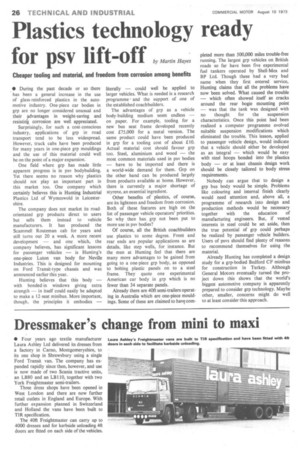Plastics technology ready
Page 28

If you've noticed an error in this article please click here to report it so we can fix it.
for psv lift-off by Martin Hayes Cheaper tooling and material, and freedom from corrosion among benefits • During the past decade or so there has been a general increase in the use of glass-reinforced plastics in the automotive industry. One-piece car bodies in grp are no longer considered unusual and their jadvantages in weight-saving and resisting corrosion are well appreciated.
Surprisingly, for such a cost-conscious industry, applications of grp in road transport tend to be less widespread. However, truck cabs have been produced for many years in one-piece grp mouldings and the use of this material could well be on the point of a major expansion.
One field where grp has made little apparent progress is in psv bodybuilding. Yet there seems no reason why plastics should not play an important part in this market too. One company which certainly believes this is Hunting Industrial Plastics Ltd of Wymeswold in Leicestershire.
The company does not market its roadorientated grp products direct to users but sells them instead to vehicle manufacturers. It has produced the Scammell Routeman cab for years and still turns out 20 a week. A more recent development — and one which, the company believes, has significant lessons for passenger vehicles — is Hunting's one-piece Luton van body for Neville Industries. This is designed for mounting on Ford Transit-type chassis and was announced earlier this year.
Hunting believes that this body — with bonded-in windows giving extra strength — in itself could easily be adapted to make a 12-seat minibus. More important, though, the principles it embodies — literally — could well be applied to larger vehicles. What is needed is a research programme • and the support of one of the established coachbuilders.
The advantages of grp as a vehicle body-building medium seem endless — on paper. For example, tooling for a new bus seat frame developed recently cost £75,000 for a metal version. The same product could have been produced in grp for a tooling cost of about £10. Actual material cost should favour grp too. Steel, aluminium and wood — the most common materials used in psv bodies — have to be imported and there is a world-wide demand for them. Grp on the other hand can be produced largely from products available at home. However, there is currently a major shortage of styrene, an essential ingredient.
Other benefits of plastics, of course, are its lightness and freedom from corrosion. Both of these features are high on the list of passenger vehicle operators' priorities. So why then has grp not been put to more use in psv bodies?
Of course, all the British coachbuilders use plastics to some degree. Front and rear ends are popular applications as are details, like step wells, for instance. But the men at Hunting feel that there are many more advantages to be gained from going to a one-piece grp body, as opposed to bolting plastic panels on to a steel frame. They quote one experimental American car body in grp which is no fewer than 34 separate panels.
Already there are 40ft semi-trailers operating in Australia which are one-piece mouldings. Some of these are claimed to have corn
pleted more than 500,000 miles trouble-free running. The largest grp vehicles on British roads so far have been five experimental fuel tankers operated by Shell-Mex and BP Ltd. Though these had a very bad name when they first entered service, Hunting claims that all the problems have now been solved. What caused the trouble — which often showed itself as cracks around the rear bogie mounting point — was that the tank was designed with no thought for the suspension characteristics. Once this point had been realized a computer programme evolved suitable suspension modifications which eliminated the trouble. This lesson, applied to passenger vehicle design, would indicate that a vehicle should either be developed as an integral -which would be easy with steel hoops bonded into the plastics body — or at least chassis design work should be closely tailored to body stress requirements.
Nobody can argue that to design a grp bus body would be simple. Problems like colouring and internal finish clearly would need attention and, above all, a programme of research into design and production methods would be necessary together with the education of manufacturing engineers. But, if vested interests in steel could be set aside, then the true potential of grp could perhaps be realized by passenger vehicle builders. Users of psvs should find plenty of reasons to recommend themselves for using the material.
Already Hunting has completed a design study for a grp-bodied Bedford CF minibus for construction in Turkey. Although General Motors eventually turned the project down this shows that the world's biggest automotive company is apparently prepared to consider grp technology. Maybe other, smaller, concerns might do well to at least consider this approach.




























































































